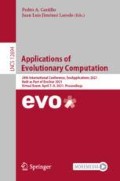Abstract
Quality-diversity (QD) algorithms that return a large archive of elite solutions to a problem provide insights into how high-performing solutions are distributed throughout a feature-space defined by a user. They are often described as illuminating the feature-space, providing a qualitative illustration of relationships between features and objective quality. However, if there are 1000 s of solutions in an archive, extracting a succinct set of rules that capture these relationships in a quantitative manner (i.e. as a set of rules) is challenging. We propose two methods for the automated generation of rules from data contained in an archive; the first uses Genetic Programming and the second, a rule-induction method known as CN2. Rules are generated from large archives of data produced by running MAP-Elites on an urban logistics problem. A quantitative and qualitative evaluation that includes the end-user demonstrate that the rules are capable of fitting the data, but also highlights some mismatches between the model used by the optimiser and that assumed by the user.
Access this chapter
Tax calculation will be finalised at checkout
Purchases are for personal use only
References
Arnaldo, I., Veeramachaneni, K., Song, A., O’Reilly, U.: Bring your own learner: a cloud-based, data-parallel commons for machine learning. IEEE Comput. Intell. Mag. 10(1), 20–32 (2015). https://doi.org/10.1109/MCI.2014.2369892
Arnaldo, I., Krawiec, K., O’Reilly, U.M.: Multiple regression genetic programming. In: Proceedings of the 2014 Annual Conference on Genetic and Evolutionary Computation, pp. 879–886 (2014)
Clark, P., Boswell, R.: Rule induction with CN2: some recent improvements. In: Kodratoff, Y. (ed.) EWSL 1991. LNCS, vol. 482, pp. 151–163. Springer, Heidelberg (1991). https://doi.org/10.1007/BFb0017011
Clark, P., Niblett, T.: The CN2 induction algorithm. Mach. Learn. 3(4), 261–283 (1989)
Cully, A., Clune, J., Tarapore, D., Mouret, J.B.: Robots that can adapt like animals. Nature 521(7553), 503 (2015)
Demšar, J., et al.: Orange: data mining toolbox in python. J. Mach. Learn. Res. 14, 2349–2353 (2013). http://jmlr.org/papers/v14/demsar13a.html
Espejo, P.G., Ventura, S., Herrera, F.: A survey on the application of genetic programming to classification. IEEE Trans. Syst. Man Cybern. Part C (Applications and Reviews) 40(2), 121–144 (2009)
Fioravanzo, S., Iacca, G.: Evaluating map-elites on constrained optimization problems. In: Proceedings of the Genetic and Evolutionary Computation Conference Companion, pp. 253–254. ACM (2019)
Garcia-Almanza, A.L., Alexandrova-Kabadjova, B., Martinez-Jaramillo, S.: Understanding bank failure: a close examination of rules created by genetic programming. In: 2010 IEEE Electronics, Robotics and Automotive Mechanics Conference, pp. 34–39. IEEE (2010)
Hagg, A., Asteroth, A., Bäck, T.: Prototype discovery using quality-diversity. In: Auger, A., Fonseca, C.M., Lourenço, N., Machado, P., Paquete, L., Whitley, D. (eds.) PPSN 2018. LNCS, vol. 11101, pp. 500–511. Springer, Cham (2018). https://doi.org/10.1007/978-3-319-99253-2_40
Haklay, M., Weber, P.: Open streetmap: user-generated street maps. IEEE Pervasive Comput. 7(4), 12–18 (2008). https://doi.org/10.1109/MPRV.2008.80
Lavrac, N., Kavsek, B., Flach, P.A., Todorovski, L.: Subgroup discovery with CN2-SD. J. Mach. Learn. Res. 5, 153–188 (2004)
Mouret, J., Clune, J.: Illuminating search spaces by mapping elites. CoRR (2015)
Ribeiro, M.T., Singh, S., Guestrin, C.: “why should i trust you?”: explaining the predictions of any classifier. In: Proceedings of the 22nd ACM SIGKDD International Conference on Knowledge Discovery and Data Mining, KDD 2016, pp. 1135–1144. Association for Computing Machinery, New York, NY, USA (2016). https://doi.org/10.1145/2939672.2939778
Swe, S.M., Sett, K.M.: Approaching rules induction CN2 algorithm in categorizing of biodiversity. Int. J. Trend Sci. Res. Dev. 3(4), 1581–1584 (2019). https://doi.org/10.5281/zenodo.3591374
Tokinaga, S., Lu, J., Ikeda, Y.: Neural network rule extraction by using the genetic programming and its applications to explanatory classifications. IEICE Trans. Fundam. Electron. Commun. Comput. Sci. 88(10), 2627–2635 (2005)
Urquhart, N., Hart, E.: Optimisation and illumination of a real-world workforce scheduling and routing application (WSRP) via map-elites. In: Auger, A., Fonseca, C.M., Lourenço, N., Machado, P., Paquete, L., Whitley, D. (eds.) PPSN 2018. LNCS, vol. 11101, pp. 488–499. Springer, Cham (2018). https://doi.org/10.1007/978-3-319-99253-2_39
Urquhart, N., Höhl, S., Hart, E.: An illumination algorithm approach to solving the micro-depot routing problem. In: Proceedings of the Genetic and Evolutionary Computation Conference (2019). https://doi.org/10.1145/3321707.3321767
Vassiliades, V., Chatzilygeroudis, K., Mouret, J.B.: Using centroidal voronoi tessellations to scale up the multi-dimensional archive of phenotypic elites algorithm. IEEE Trans. Evol. Comput. 1 (2017)
Author information
Authors and Affiliations
Corresponding author
Editor information
Editors and Affiliations
Rights and permissions
Copyright information
© 2021 Springer Nature Switzerland AG
About this paper
Cite this paper
Urquhart, N., Höhl, S., Hart, E. (2021). Automated, Explainable Rule Extraction from MAP-Elites Archives. In: Castillo, P.A., Jiménez Laredo, J.L. (eds) Applications of Evolutionary Computation. EvoApplications 2021. Lecture Notes in Computer Science(), vol 12694. Springer, Cham. https://doi.org/10.1007/978-3-030-72699-7_17
Download citation
DOI: https://doi.org/10.1007/978-3-030-72699-7_17
Published:
Publisher Name: Springer, Cham
Print ISBN: 978-3-030-72698-0
Online ISBN: 978-3-030-72699-7
eBook Packages: Computer ScienceComputer Science (R0)

